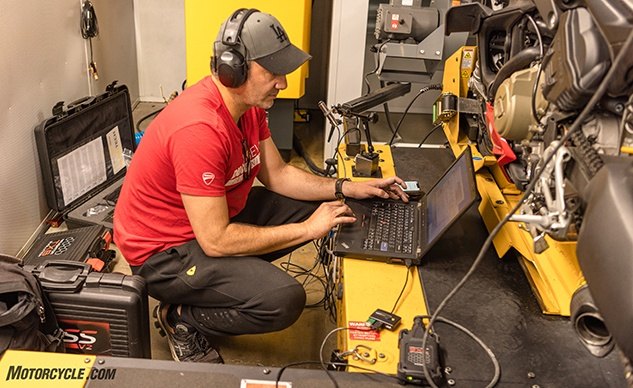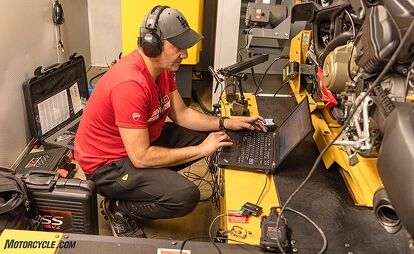ECU Flash Tuning - What Is It?

A dive into ECU tuning - the easiest way to add power.
The hot topic in motorcycle performance these days is flashing your ECU. You hear the term “flashing” brought up all the time – and no, we’re not talking about spring break antics, either. But while the term is gaining in popularity, and is often associated with big gains, we wanted to know – what the heck is ECU flashing, anyway? For that, let’s start with a little back story.
If you’re of a certain age, then you might remember the nights spent in the shop, turning wrenches and busting knuckles trying to add more power to your motorcycle. There’s an art, some might even call it a cathartic undertone, to pulling a carburetor and adjusting float levels, changing jets, moving clips, and reading spark plugs. Get it right and it’s certainly rewarding. Get it wrong (which is much more often the case), and you have to pull it all off and try again. It’s annoying and time-consuming, to say the least, and often you walk away greasy, dirty, smelling like gas, and a little pissed off. Odds are you probably lost your 10mm socket, too. All that just to gain five horsepower, if you’re lucky.
Despite the romance of it all, the digital age of motorcycling is just…better. Electronic fuel injection is better than the carburetor. Same goes for ride-by-wire throttles. The precision each bit of tech offers is far superior to its analog counterparts. But therein lies the rub; change is hard, and technology can be intimidating to some people. Especially when it comes to making a motorcycle better. Enter the world of ECU flash tuning.
What Is Flash Tuning?
Modern motorcycles rely on the Electronic Control Unit (or a series of ECUs) to provide basically every necessary electronic input to make the bike perform. For the purposes of this article, we’ll focus on the delivery of fuel, spark, and air. With modern fuel injection and electronic throttles in stock trim, what we’re requesting with our right wrist isn’t always what the motorcycle is delivering.
OEMs spend a great deal of time developing specific lines of code to meet certain requirements, primarily emissions-related, in order to make authorities happy and to be able to sell the bike all around the world. By definition, however, those settings compromise maximum performance in order to meet government regulations. This much hasn’t changed between analog bikes and digital.
Whereas in the past we’d have to get our hands dirty and physically alter or change a part, today we can gain back a considerable amount of performance by simply plugging in a computer and altering specific lines of code set by the OEM.
How It Works
To guide us into the world of ECU flashing, we turned to Shiv Pathak, proprietor of Open Flash Performance. While Pathak mainly deals with tuning ECUs for the car world, he’s no stranger to motorcycles. “Bikes are way more fun,” Pathak says, “but the car business pays the bills.”
Upon receiving a new bike, the first step Pathak takes is to put it on the dyno to get a baseline run. Peak power and torque are fun numbers to talk about, but Pathak is more curious about the entire curve. Dips, flat spots, and irregularities generally point to areas of improvement. A quick peek at the air/fuel ratio throughout the rev range could also clue us in on spots to improve.
As the saying goes, the devil is in the details, and it’s here that Pathak clues us in on a fallacy. While many aftermarket exhausts will have a bung to attach an O2 sensor and read the air/fuel mixture, the reading you’ll get from it is generally useless information. Unless you have a single-cylinder motorcycle, the sensor is located so far downstream that you’re getting an average reading from all the cylinders. “That’s not very helpful,” says Pathak. “I want to know what each individual cylinder is doing.” To do this, Pathak installs individual sensors at the header pipes, as far upstream as possible, and especially before the exhaust gasses reach any cross-over pipes.
Behind the scenes is where ECU tuners earn their pay. To keep this as layman-relatable as possible, the OEMs write their ECUs with their own language. Gaining access inside the ECU is one thing, but identifying, understanding, and then making changes using that language is another. After over two decades in the business of ECU tuning, Pathak has the hardware, software, and know-how to do it.
Generally speaking, we’re looking at fuel tables – how much fuel is being fed to the engine at any given rpm, ignition timing, and throttle mapping – the correlation between how much you twist your wrist versus how much (and how quickly) the actual throttle bodies open. With a baseline dyno pull as a reference, oxygen sensors installed, and access to the ECU established, it’s time to go to work.
Where The Magic Happens
Unlike the bikes of old that required altering a physical part in the search for power, ECU tuning is as clean as it gets. Though there’s a balance. In general, the process involves adding or subtracting ignition timing and/or fuel until any further changes result in a loss. Getting to that point, however, takes several dyno pulls to discover. If the readings from the oxygen sensor(s) reveal improper fueling, adding or subtracting fuel is a good place to start – which can be done for the whole engine or a specific cylinder, or even at certain engine speeds. The principles of engine tuning remain the same as always, and running slightly rich on the fueling is a safe bet for longevity.
Reading the fuel tables, Pathak will identify (based on the air/fuel reading on the dyno pull) where in the rev range fuel can be added or subtracted, and with the push of a button, the change will be made – no more bloody knuckles and the constant need to open up a carburetor to change something. Successive dyno pulls will tell him when to stop.
The same is true for ignition timing. A button press can advance or retard timing, and dyno pulls will reveal which direction to go. Usually, but not always, a degree more timing will net a little more power. The caveat, of course, is being careful not to trigger detonation, especially with pump gas.
This brings up another point: race gas. Or more specifically, fuel with a higher octane rating. Depending on the wants and needs of the owner, and their willingness to fill up with fuel not normally found at the pump, pushing the limits of the engine via ignition timing can be explored. Keep in mind, too, we’re talking about an otherwise standard engine with stock components.
Throttle Mapping
Another trick OEMs employ – usually to get around emissions requirements – is to limit the amount of throttle opening independent of the amount you’re actually twisting your wrist. In some cases, especially on sportbikes, twisting your hand to the stop doesn’t amount to the butterflies opening all the way. There are several reasons OEMs do this, but the result is there’s horsepower left on the table.
Pathak, and other reputable ECU tuners like him, can read the throttle tables and find where the actual amount of butterfly opening doesn’t match what’s being asked from the handlebar. Then, by simply changing those values via software, can reclaim not only power, but in many cases also better throttle application and driveability. The most egregious offender in recent memory is the 2020-present BMW S1000RR. Blatant butterfly restrictions in the midrange (at least in US trim) make it truly appalling in stock trim. After adjusting the throttle tables to properly let the engine breathe, Pathak was blown away. “It’s a whole new motorcycle,” he says, “with a torque curve thanks to the Shift Cam [Variable Valve Timing] technology that’s insanely impressive.”
Why Would You Flash an ECU? What About Piggyback Tuners?
After reading all this you might be wondering whether an ECU flash is for you. First and foremost, check the laws in your state about what modifications can be made to your motorcycle. An ECU flash produces the greatest benefit on a modified bike, but even a bone-stock motorcycle can benefit, which means your standard emissions-related hardware would all still be intact. Nonetheless, government agencies make it difficult to legally upgrade your vehicle. Arm yourself with knowledge before deciding. Also, while a flashed ECU can easily be returned back to stock settings, dealers may still be able to trace if changes were made (via the CAN port) and could then decide whether or not to void your warranty. Obviously, that would be a bad thing.
However, legalities out of the way, flashing an ECU is generally a cheap and effective option to pick up easy power and generally improve a motorcycle’s overall performance. As mentioned before, this is especially true if you have other power-adding modifications done. That said, if you’re happy with your bike the way it is, then there’s no need to spend the extra cash.
And what about piggyback tuners, you ask? In general, piggyback tuners are basically intermediaries between your ECU and the rest of the motorcycle’s subsystems. The piggyback unit will take signals from your ECU, then send slightly modified signals to the subsystems (generally related to fuel or ignition).
The biggest issue with piggyback tuners is that, on some bikes, entire portions of the rev range are “locked out” (what’s called Closed Loop) and piggyback tuners have no influence in these sections. Flashing does away with the middle-man and gives full access to the rev range. However, since piggyback units don’t alter your original ECU at all, they shouldn’t affect your warranty.
Real-World Testing/Results
Now that you have an understanding of what flash tuning is and how it works, you probably want to know how it works in the real world. To do this, we rode Pathak’s personal Ducati Streetfighter. In stock trim, it made 182 horsepower and 81 lb-ft of torque at the rear wheel. With just a flashed ECU, those numbers rose to 189 and 83.1, respectively. After swapping the stock exhaust with a slip-on unit from Arrow and flashing again, the final numbers come out to 195 hp and 83.3 lb-ft. As you can see in the dyno graph, both times the bike was flashed, the result was not only more power up top, but also a noticeably smoother power curve from top to bottom.
The Ducati Streetfighter V4 isn’t a vehicle I’ve necessarily felt needed even more power, but when you’re equipped with 13 more horses than standard, most of it situated at the top of the powerband, the only natural place to test something like this is at the racetrack.
Honestly, the bump in power is insanely impressive – and it’s not like the stock Streetfighter was lacking. The lack of any wind protection made hanging on at high speeds the biggest challenge. Also impressive was the linearity power delivery as you build through the revs, especially as you’re just cracking the throttle open coming out of a turn. The connection between hand and engine felt much more natural – which was a surprise since the stock bike wasn’t too bad to begin with. This just goes to show that there’s always room for improvement.
Tuning, The Easy Way
There you have it. A rundown on ECU flashing. Compared to the tuning methods your dad used to use, typing in keystrokes is far easier than turning wrenches. Not to mention your knuckles won’t get bloodied, your hands won’t get dirty, and your clothes won’t smell like gasoline.
That said, I’ll admit carbs themselves are pretty easy to work on, which is especially important if you need to work on one out on a ride. The prevalence of carbs still on the road today is fairly significant, and that number rises considerably in the dirtbike world since it’s still common for even new dirtbikes to have them.
A big demerit for flash tuning compared to carbs has been the fact that the average garage mechanic can’t do it themselves. Typically, flashing involves sending the bike or the ECU to a specialty shop to have them flash it and send it back to you.
This is the difference between Pathak’s Open Flash Performance tablet and the rest. Pathak is in the business of selling hardware (a tablet), which comes pre-installed with the map files for your particular motorcycle (assuming it’s one Pathak has developed a tune for). All you have to do is plug it in and push a button. This is easily done from the comfort of your own garage. Should any future maps be created or updates made, those files (and any others) are available for free.
However, not all bikes can be flashed as tuners tend to target popular models to crack the ECU’s code. Other bikes have security lockouts that are difficult to crack. If your bike falls into one of these categories, a piggyback tuner is the way to go. Assuming your bike’s ECU can be flashed, it’s an attractive option to unlock power and have a nicer power curve.

Troy's been riding motorcycles and writing about them since 2006, getting his start at Rider Magazine. From there, he moved to Sport Rider Magazine before finally landing at Motorcycle.com in 2011. A lifelong gearhead who didn't fully immerse himself in motorcycles until his teenage years, Troy's interests have always been in technology, performance, and going fast. Naturally, racing was the perfect avenue to combine all three. Troy has been racing nearly as long as he's been riding and has competed at the AMA national level. He's also won multiple club races throughout the country, culminating in a Utah Sport Bike Association championship in 2011. He has been invited as a guest instructor for the Yamaha Champions Riding School, and when he's not out riding, he's either wrenching on bikes or watching MotoGP.
More by Troy Siahaan























































Comments
Join the conversation
I had my 2000 GSXR 750 reflashed for race gas and it made a hundred 47 on the back tire I was much smoother ride on the race track best thing I ever did
The older piggyback tuners did not have the blocked off "EPA" area on their tables. Ah, the good old days!
My experience is with Yamahas, which suffer from on/off jerky throttle response. My '14 Super Tenere was annoying, my '06 FZ1 was so bad it was actually bordering on dangerous in this regard. Flashing both bike's ECUs made a massive improvement, making their systems feel like an always perfectly dialed set of analog carbs - creamy, smooth and responsive.
The Super T has a Yosh can on it and the uncorked 270 degree twin sounds wonderful, but still wears it's CAT, so I am not feeling bad about it's pollution levels. Giving up a few HP on that bike's top end, but the ADV bike is not really about top end anyway.
The FZ1 has an Akra full exhaust and had its secondary butterflies removed with ECU mapping to match. The throttle grip is cabled to the primaries and without ECU controlled fun police nanny secondary butterflies, it is smooth and yet immediate and manic. The bike is fully capable of putting a careless/stupid rider in the hospital in a hurry, just as a fast sportyish liter class bike should be.
I hang onto the FZ as it is fun of course, but also because it is not worth much now, and in part because I truly am concerned they typical young buyer who picks up a $3,000ish liter class bike will seriously hurt themselves on that machine ;)